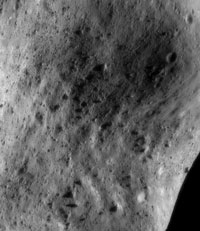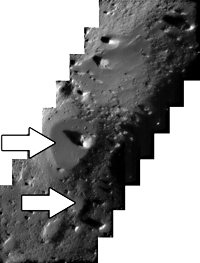 |
| Boulders (136103971-136104281) |
When looking at the highest resolution images, smaller features
on the surface become more visible. (<100 m). Boulders, slides, streamers,
and ponds make up the small scale feature category that can be seen with the
Multi-Spectral Imager.
Throughout the year-long mission, 6,760 boulders (>15m across) were found scattered
on the surface of Eros. These boulders were ejected from impact craters. The presence
of the boulders on the surface confirmed that Eros is not a rubble pile, but a
solid coherent body. The boulders also helped determine the relative age of the
large craters on Eros. This was done by mapping the boulders and then mapping
the predicted ejecta patterns from the different large craters. Using the data,
researchers determined that quite a few of the boulders on Eros came from one
crater, Shoemaker crater. In fact 44% of the boulders are within the rim of Shoemaker
crater (Thomas et al. 2001). The results also
determined that Shoemaker crater is the youngest of the big three craters (Himeros,
Psyche, and Shoemaker crater) because the ejecta covered areas of the other two
craters. This result also brings up more questions: Why
do we see only boulders from one of the craters? One possible answer to this question
may be that the regolith on Eros is deeper than we imagine. Therefore it takes
a very large impact like Shoemaker's impact to reach the coherent rock which creates
the boulders.

Boulders (136103971-136104281)
 |
| Streamers on the East wall of Himeros (141204041-141204537) |
One of the more surprising discoveries made during the NEAR mission was the mostly flat areas made of small regolith particles called ponds. These ponds were found to accumulate within 30 degrees of the equator. The ponds added to the evidence that Eros had a layer of regolith. This is important because before the NEAR mission, it was thought that it was very possible that there was not enough gravity on an asteroid like Eros (which has 0.1 percent of earth gravitational force) to hold the loose particles on the surface.
To form these flat regions there must be a force to move the
regolith particles around the surface. (You must remember that there is no wind).
It has been proposed that the ponds were formed over long periods of time by
static electricity. It is believed that there is a buildup of static electricity
from the long periods of sunlight on portions of the asteroid. The static electricity
lifted up the particles and moved them slowly until the particles were collected
and trapped in depressions on the surface, like craters.

Ponds (156087831-156087866)
Another possible technique for forming ponds is by seismic shaking. Impacts on the surface of Eros, especially large ones, would send shock waves around the asteroid. The waves could very easily loosen regolith and then shake it like a bucket of sand until the regolith leveled out in a shallow area (Robinson et al. 2001).
Some of the low altitude flyover movies like MSI_LowAlt_Closest_1 and MSI_LowAlt_Closest_2 depict a few good examples of ponds on Eros.